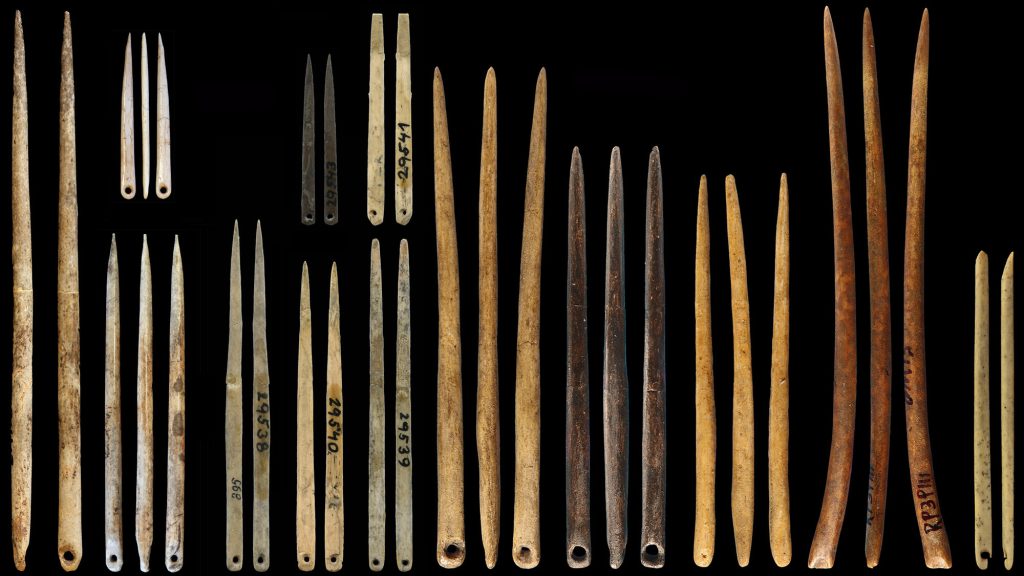Sewing Needles Reveal the Roots of Fashion

The Inya River in southwestern Siberia winds through a landscape of striking seasonal changes. In the summer, crystal clear waters lap below alpine forests. As winter approaches, the river freezes, fierce snowstorms shroud the mountains, and temperatures plummet.
The climate becomes perilous to humans. But evidence of 50,000-year-old hunting tools suggests that Stone Age hunter-gatherers once inhabited the region. What was their secret to survival? Clothing.
Last year, in a cave above the Inya River’s middle reaches, scientists discovered 20,000-year-old sewing needles. Despite their ancient origin, the needles are sophisticated. Not only are they sharp enough to perforate thick animal hides, they possess a needle “eye,” which would have allowed early tailors to thread the needle and sew.
In a new study, published in the December issue of the Journal of Human Evolution, a team of researchers has pieced together what we know about ancient garment making using needle artifacts collected around the world, including from the site by the Inya River. Sewing, the analysis reveals, can offer a portal into human technology and cognition in the Upper Paleolithic, a period stretching from 50,000 to 10,000 years ago.
“Many of the needles we discovered were not simply used to manufacture clothes but for embroidery and ornaments. There was an aesthetic role,” says Francesco d’Errico, an anthropologist at the University of Bordeaux in France and a co-author of the study.
In other words, ancient humans were not only concerned with finding warmth in wintry weather—they also may have dressed in order to communicate social identity, display tribal affiliations, and, indeed, to look good.
The very earliest evidence for clothing fabrication comes from an unlikely source: lice. Between 80,000 and 100,000 years ago, head and body lice became separate species. “This is an indication that individuals started wearing skins,” says Sarah Wurz, an anthropologist at the University of the Witwatersrand, who was not associated with the d’Errico study. “The lice lived in these, and therefore evolved into a separate species.”
We do not know which Homo species—neanderthalensis or sapiens—first pioneered the practice of wearing furs. But by 76,000 years ago, anthropologists believe that Homo sapiens were creating bone awls, a precursor to the needle, in South Africa. In the millennia to follow, artifacts suggest most ancient clothing production was occurring in the Northern Hemisphere, where cooler climes made extra insulation helpful.
For the new study, d’Errico and his colleagues amassed a database of eyed sewing needles found in the Northern Hemisphere, many of which date to the Upper Paleolithic period. They analyzed all of the needles in terms of both their form and function. Radiocarbon dating enabled the team to assess the age of various specimens.
The researchers found that humans developed eyed sewing needles in what is now Siberia and China as early as 45,000 years ago. In Europe, clothing fabrication likely began around 26,000 years ago; it probably began some 13,000 years ago in North America.
In addition, d’Errico and his colleagues uncovered evidence of extensive production sites for needles and garments. For example, at a site in the northern deserts of China, researchers extracted needles that were more than 10,000 years old, along with tools that may have aided their creation. Some of the needles are wide and flat, perhaps used to stitch thick hides. Others are narrow and circular, which may indicate they were used for delicate work such as embroidery.
The researchers also discovered that some of the world’s most sophisticated early stitch work may have come from North America. Sites in eastern Wyoming and central Washington yielded 13,000-year-old needles that have a striking level of refinement and suggest what the researchers call a “never previously achieved mastery” in needle production.
The incredible diversity of needle types, which differed by region, exhibited varied forms, and evolved over time, suggests two things. First, multiple societies created them independently. Second, people within these societies had tools to create different types of garments, which may have had cultural or aesthetic significance. In Western Europe, for instance, where anthropologists believe distinctive groups of humans frequently interacted, needle styles varied by site, suggesting dressing style might have delineated tribal affiliation.
There’s other evidence for decorative dress in the Upper Paleolithic. For example, in a previous project, d’Errico and his colleague Marian Vanhaeren, an anthropologist at the University of Bordeaux, identified shells on the remains of a child in the Madeleine Cave in France, a site they attribute to the late Magdalenian period, around 10,000 years ago. Tiny holes hint that someone stitched these ornaments to the child’s clothing, though the textile itself has since disintegrated.
At the same time that the needle unleashed an aesthetic revolution in clothing, it might have signaled two other developments integral to human prehistory: the ability to travel long distances and the capacity for complex thought.
Anthropologists believe that around 50,000 years ago, the first Homo sapiens began leaving Africa and heading northward. “One of the burning questions in early human research is what technologies allowed people to move out of Africa and eventually colonize the rest of the world,” says Justin Bradfield, an anthropologist based at the University of Johannesburg in South Africa, who was not associated with the study.
The new study does not definitively determine whether sewing needles enabled human migrations, but it hints that their role could have been crucial. After all, some of the most sophisticated specimens are associated with people in North America—who also happened to traverse the farthest distances across the harshest climates. Being able to sew warm garments may have opened the door to the New World.
In addition, the needles offer a clue to the cognitive abilities of people who lived during the Upper Paleolithic, which would later make possible architecture and forgery. “The production process involved in making and using needles involves many steps,” Wurz says. People would conceptualize the need for a tool, find the correct materials, produce thread, and sew clothing, she explains. “This long chain of thought and combination of different elements are evidence for complex cognition that typify all humans today.”
































